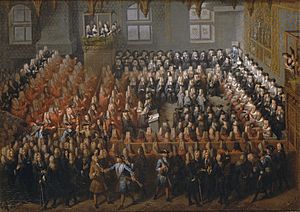Parliament of Paris facts for kids

The Parliament of Paris (French: Parlement de Paris) was the oldest parlement in the Kingdom of France, formed in the 13th century. It was fixed in Paris by Philip IV of France in 1302. The Parliament of Paris would hold sessions inside the medieval royal palace on the Île de la Cité, nowadays still the site of the Paris Hall of Justice.
History
In 1589, Paris was effectively in the hands of the Catholic League. To escape, Henry IV of France summoned the parliament of Paris to meet at Tours, but only a small faction of its parliamentarians accepted the summons. (Henry also held a parliament at Châlons, a town remaining faithful to the king, known as the Parliament of Châlons.) Following the king's assassination by the Dominican lay brother Jacques Clément, the "Parliament of Tours" continued to sit during the first years of Henry IV of France's reign. The royalist members of the other provincial parliaments also split off—the royalist members of the Parliament of Rouen seceded to Caen, those in the Parliament of Toulouse to Carcassonne, and those of Parliament of Dijon to Semur and to Flavigny.
The Parliament of Paris played a major role in stimulating the nobility to resist the expansion of royal power by military force in the Parliamentary Fronde, 1648–1649. In the end, King Louis XIV won out and the nobility was humiliated.
At a session of the Parliament of Paris on 3 March 1766 known as la Séance de la Flagellation ("the Flagellation Session"), Louis XV asserted that sovereign power resided in his person only.
Images for kids
See also
 In Spanish: Parlamento de París para niños
In Spanish: Parlamento de París para niños



